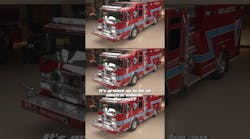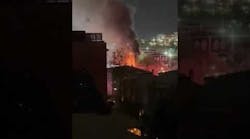All too often a fire chief finds themselves in the middle of a conflict between firefighters. Career firefighters, as well as volunteers have this problem. It must be human nature. "Why can't we all just get along?"
For career firefighters the problem rarely gets past the front door. When you are stuck in the firehouse until the end of your shift, things will usually get worked out. The close quarters and more constant interaction will bring things to a head more quickly. But for volunteers when there is a problem it can get out of the building and into the community. This is due in part to the fact that volunteers interact with each other on different levels. School, church and sports activities bring volunteers together outside the firehouse. When things are going well, this interaction builds camaraderie, but when there is a conflict it can manifest itself in many aspects of the community. Soon people with no connection to the firehouse will be bringing up the subject.
Conflicts can arise from many sources. They can arise from the outside or from within the firehouse. Problems may arise from within the firehouse when members perceive that others are receiving preferential treatment, whether it is real or imagined. This is not to say that you can't reward outstanding performance, but you should treat everyone fairly. If you must discipline a member make sure the punishment fits the crime and the same punishment is applied to everyone.
When a situation arises from the community and is brought into the firehouse it is far worse. The chief may have to deal with it even if it's not a fire department matter. He or she may have little or no authority in the matter and may find that they are just another person with an opinion. An opinion he or she should probably keep to him or herself. Like it or not, you are a community leader and your opinion has weight. What you say may be perceived as expressing the opinion of the department, and that may be the furthest thing from the truth.
The Four Steps Of Conflict Resolution
For me, the four steps to conflict resolution are: 1. get to the root of the problem 2. find the common ground 3. work toward a compromise 4. move on
The first step in resolving a conflict is to get to the root of the problem. You need to understand what has brought on this problem. "Just the facts" may not be enough if this problem stems from an old, unresolved conflict. You need to look at the whole problem.
For the career departments, if two firefighters can't get along you may be able to assign them to different shifts. That may solve the problem, but it does not resolve the conflict.
As volunteers we have to work with who shows up. Issues need to be resolved as quickly as possible. I've heard of a volunteer chief who took two members who couldn't get along and put them on alternate days. Firefighter 1 could respond to alarms and come to the firehouse on odd days and Firefighter 2 had the even days until the matter was resolved.
Once you understand the problem you need to find the common ground. Somewhere within the underlying issue there has to be something they both agree on. In the example above, the two wanted what was best for the department and were passionate in their belief. This difference of opinion on what is best for the company then became the common ground. Ultimately the men resolved to agree to disagree, but it was their mutual respect for the chief and the department that lead them to bury the hatchet.
That brings you to the third phase of the solution. Work toward a compromise. If all the parties can come to the common ground, then a compromise can be reached. If the common ground is what's best for the company and not what's best for an individual then discuss the problem and have each side present its argument and then decide. If you have reached this point it is obvious that all sides are passionate about their opinion. Don't let that passion go to waste. Channel that energy into finding a solution, not arguing about it.
Which brings us to the last part of conflict resolution: that is to move on. That's right, get over it. If you have worked out a compromise, and it is truly a compromise then no one party will get everything they want. To bring the subject up over and over for the express purpose of rubbing salt in the wound will only make matters worse. If you are the person whose view is proven to be correct, take the high road and consider the others feelings. Next time you may be the one in error.
Personality conflicts have been around since the fire service began. For many towns the creation of multiple companies is the result of an unresolved conflict. Like-minded individuals would leave a company and start their own within the department. Volunteer firefighters in a town that I familiar with had one company. But, years ago one group wanted to embrace a more contemporary approach to firefighting, while the other favored a more traditional view. The two groups, with opposing views, could not work out issues so a group of individuals with the contemporary view left and started their own company. Today there are two companies and the difference is a clear as the red and yellow of their apparatus. This is the extreme and the fire chiefs and the fire district commissioners have to walk a very fine line so as not to show any favoritism to either company.
Chiefs and company officers who find themselves in the middle of a conflict may need to position themselves somewhere between playing the role of King Solomon and a referee. The smooth running of the company or department is the responsibility of all the officers. Conflicts have to be settled quickly and appropriately so they don't manifest themselves on the fireground. Remember we are here to fight fires, not each other.
Questions and comments are welcomed, send them to: [email protected].
Look for the next article, "The Journey: Little Things"
Stay safe.
CHRISTOPHER FLATLEY, a Firehouse.com Contributing Editor, is a 20-year veteran of the FDNY and a lieutenant currently assigned to Ladder Company 21 in Manhattan. Chris has twice served as chief of the Blauvelt, NY, Volunteer Fire Company and is currently the assistant chief and training coordinator. He is a nationally certified Fire Instructor 1 and is an instructor at the Rockland County, NY, Fire Training Center and holds a degree in fire protection technology. He is a Master Exercise Practitioner on the Exercise Design Team through the Center for Terrorism and Disaster Preparedness. View all of Chris' articles here. You can reach Chris by e-mail at: [email protected].





